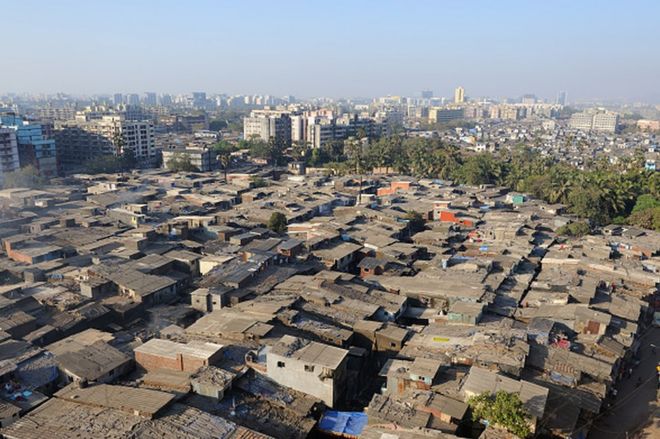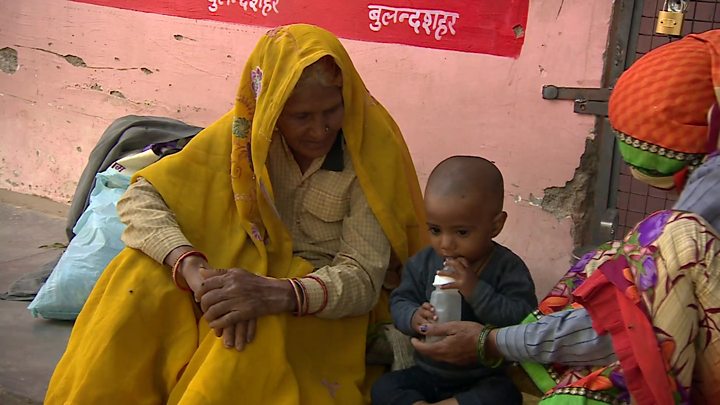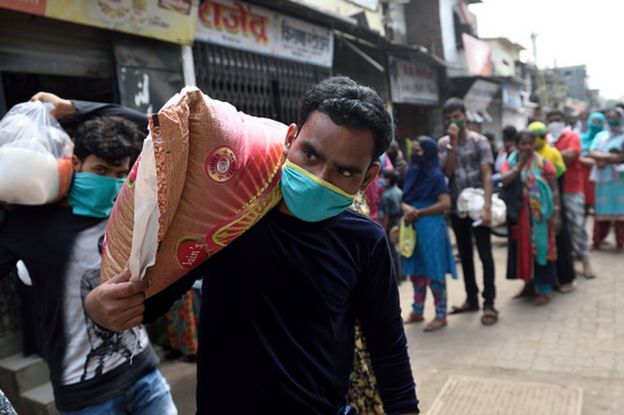BBC (extracts only):
Coronavirus: The race to stop the virus spread in Asia's 'biggest slum'

Soutik Biswas (India correspondent)
 |
More than 650,000 people live in 50 acres of space in Dharavi Image copyright GETTY IMAGES |
On 23 March, a 56-year-old man living in a vast, labyrinthine slum in the western Indian city of Mumbai went to see a doctor. He was feeling feverish and had a bad cough.
The garment trader lived in Dharavi where more than half-a-million people are spread over 2.5 grubby sq km, which is less than a square mile. (Imagine a population larger than Manchester living in an area smaller than Hyde Park and Kensington Gardens.) The slum was the inspiration for the Oscar-winning Slumdog Millionaire film and city planners from all over the world have studied its throbbing economy and society.
The local doctor examined the man and he left with a prescription for cough syrup and paracetamol. Three days later, the man turned up at the private Sion Hospital close to home. His fever had climbed and the cough was getting worse. He said he had no travel history, so doctors gave him more cough syrup and sent him home once again.
On 29 March, the man returned to the hospital with signs of respiratory distress. Doctors admitted him, and promptly sent swabs for the Covid-19 test.
Three days later, the results arrived - he had tested positive. His condition deteriorated sharply and doctors tried to move him to a bigger hospital already treating Covid - patients.
The garment trader lived in Dharavi where more than half-a-million people are spread over 2.5 grubby sq km, which is less than a square mile. (Imagine a population larger than Manchester living in an area smaller than Hyde Park and Kensington Gardens.) The slum was the inspiration for the Oscar-winning Slumdog Millionaire film and city planners from all over the world have studied its throbbing economy and society.
The local doctor examined the man and he left with a prescription for cough syrup and paracetamol. Three days later, the man turned up at the private Sion Hospital close to home. His fever had climbed and the cough was getting worse. He said he had no travel history, so doctors gave him more cough syrup and sent him home once again.
On 29 March, the man returned to the hospital with signs of respiratory distress. Doctors admitted him, and promptly sent swabs for the Covid-19 test.
Three days later, the results arrived - he had tested positive. His condition deteriorated sharply and doctors tried to move him to a bigger hospital already treating Covid - patients.
 |
As cases of coronavirus rise and the virus hits India's congested slums, will the country cope? |
It was too late: he died that evening.
That garment trader was the first Covid-19 patient from Dharavi. People living in this packed-to-the gills slum city suffer from all the common diseases afflicting Mumbai, one of the world's most densely-populated cities, from diarrhoea to malaria.
But an outbreak of coronavirus in a place where social distancing is an oxymoron could easily turn into a grave public health emergency and overwhelm the city's stretched public health system.
Nobody realises this more than the officials racing to track and contain the infection.
Patient No 1 of Dharavi lived with his eight-member family - his wife, four daughters, and two sons - in a poky 420 sq ft one-room apartment in a low-rise slum tenement ringed by squalid shanties.
"When we asked his family, they told us the man had no recent travel history and only went to the local mosque," Kiran Dighavkar, an assistant municipal commissioner in charge of the area, told me.
But there was a twist in the tale.
The man owned another apartment in the same complex. There he hosted five people who had reportedly arrived from Delhi after attending a conference in early March organised by Tablighi Jamaat, a religious movement that has followers in more than eight countries including Indonesia, Malaysia and the US.
That garment trader was the first Covid-19 patient from Dharavi. People living in this packed-to-the gills slum city suffer from all the common diseases afflicting Mumbai, one of the world's most densely-populated cities, from diarrhoea to malaria.
But an outbreak of coronavirus in a place where social distancing is an oxymoron could easily turn into a grave public health emergency and overwhelm the city's stretched public health system.
Nobody realises this more than the officials racing to track and contain the infection.
Patient No 1 of Dharavi lived with his eight-member family - his wife, four daughters, and two sons - in a poky 420 sq ft one-room apartment in a low-rise slum tenement ringed by squalid shanties.
"When we asked his family, they told us the man had no recent travel history and only went to the local mosque," Kiran Dighavkar, an assistant municipal commissioner in charge of the area, told me.
But there was a twist in the tale.
The man owned another apartment in the same complex. There he hosted five people who had reportedly arrived from Delhi after attending a conference in early March organised by Tablighi Jamaat, a religious movement that has followers in more than eight countries including Indonesia, Malaysia and the US.
 |
Dharavi has been under a lockdown since 24 March Image copyright GETTY IMAGES |
Hundreds of people who attended the religious event in the capital set off several Covid-19 clusters across the country and are now linked to some 650 cases across 14 states.
The police believe the five men lived in the Dharavi apartment for two days - between 19 and 21 March- before they left for Kerala. "We are trying to trace these people," said Mr Dighavkar.
The police believe the five men lived in the Dharavi apartment for two days - between 19 and 21 March- before they left for Kerala. "We are trying to trace these people," said Mr Dighavkar.
Yea man.. we should put the blame on Sri Petaling Tabligh Conference (held on 28-02-20 to 03-03-20) for that Covid-19 cases in the Asia's biggest slum too, even though we had nothing to do with the conferences held in Indonesia, India, and Pakistan.
ReplyDelete